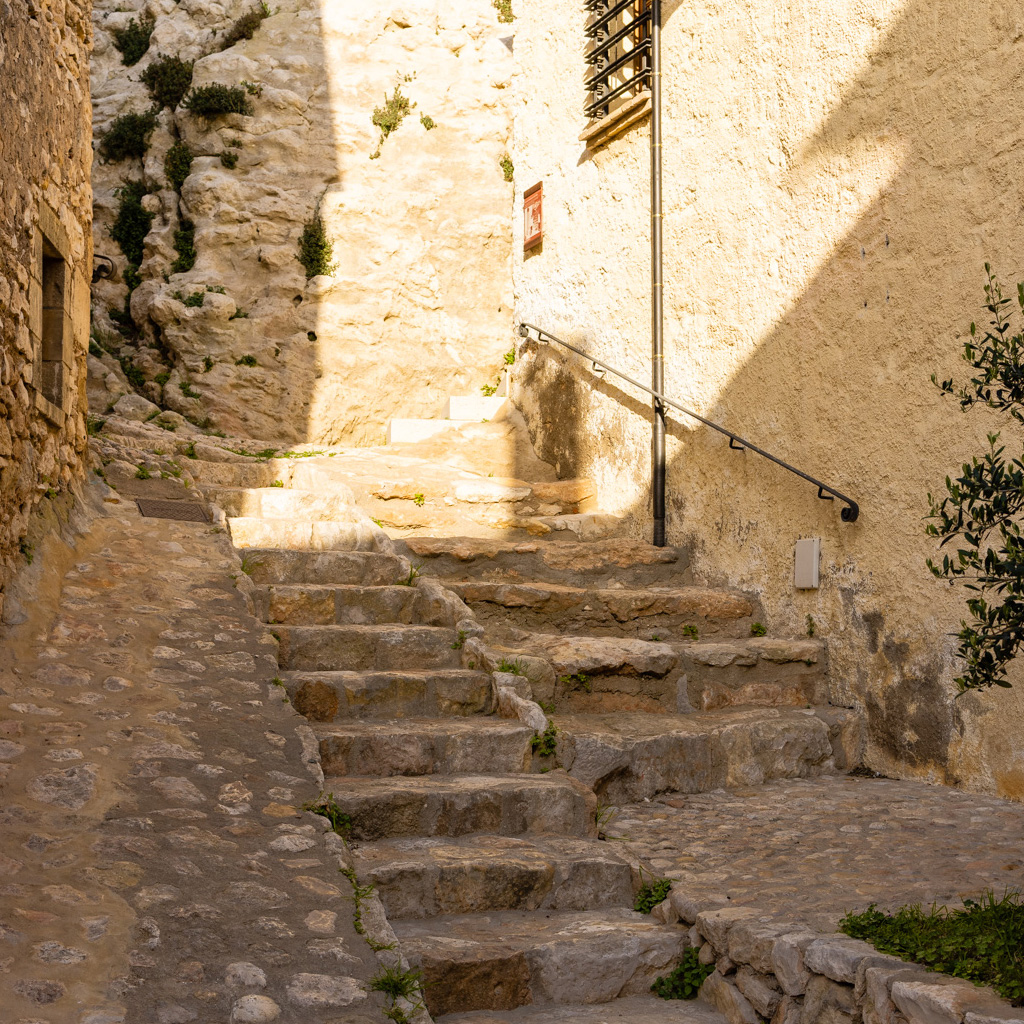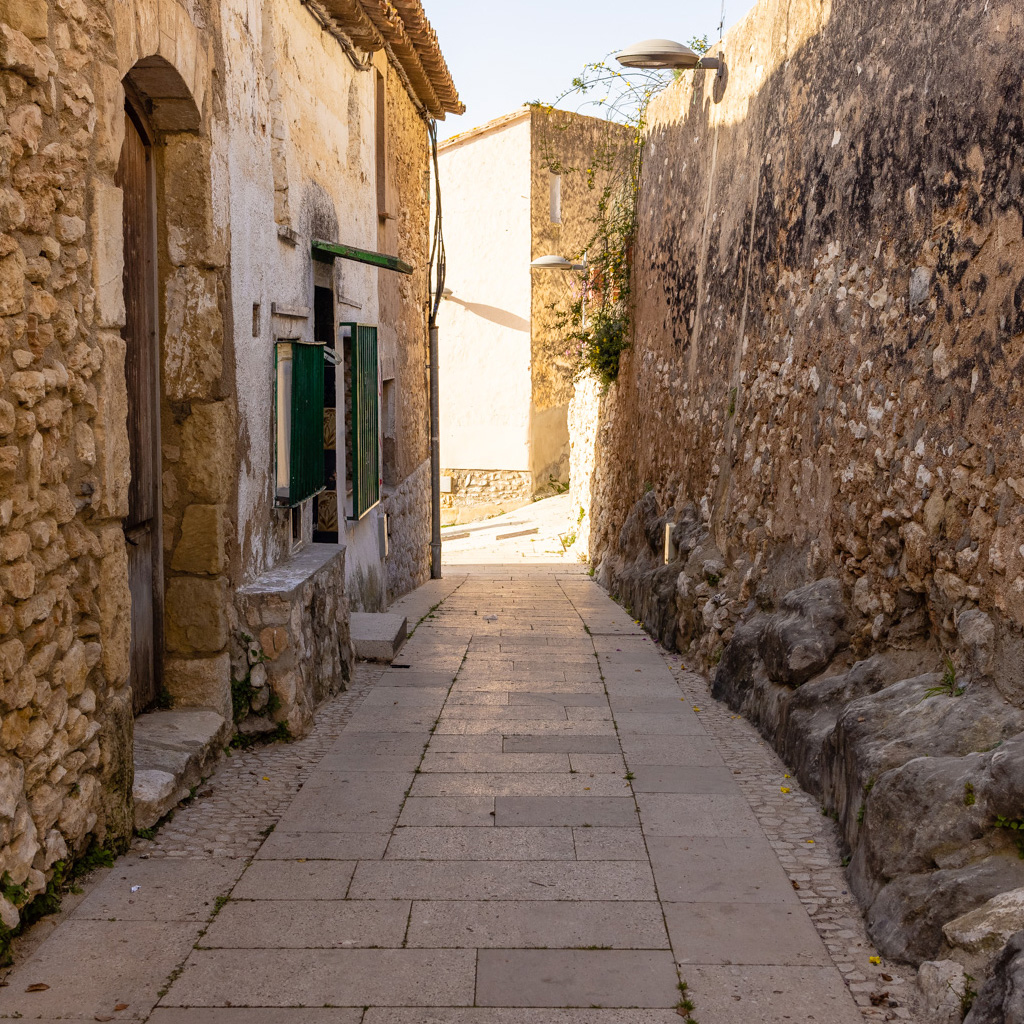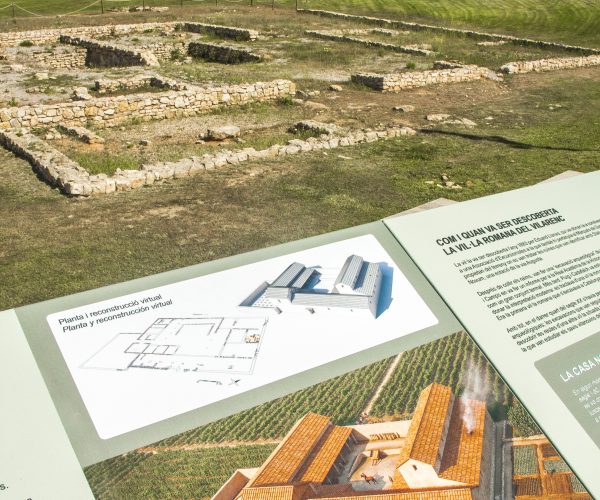Places of interest
The beach and the seafront promenade
Calafell boasts a straight and continuous seafront promenade measuring five kilometres long – which is something quite unheard-of in Catalonia.
It is divided into three beaches: Calafell beach, which coincides with the district of Calafell Beach, Segur beach, which coincides with the seafront of the district of Segur de Calafell, and l’Estany-Mas Mel beach, located in front of the two neighbourhoods bearing these names.
Sculptures
Four iconic sculptures by Calafell-born Fina Oliver, dotted along the fascinating Passeig Marítim de Sant Joan de Déu at Calafell Beach, together with some texts by different writers, bear witness to a rich literary history, turning this promenade into a veritable open-air museum.
Tribute to Carlos Barral, poet, editor and sailor.
- Material: bronze
- Year: 2015
- Sculptor: Fina Oliver
- Location: Passeig Marítim de Sant Joan de Déu, near the Casa Barral Museum.
Dedicated to Calafell past as a fishing village. The boxes are reminiscent of the fish auctions.
- Material: Bronze
- Year: 2015
- Sculptor: Fina Oliver
- Location: Passeig Marítim de Sant Joan de Déu, beside the Fishermen’s Interpretation Centre.
Tribute to female net-menders. It’s netting needles to mend nets. You can see the names of female net-menders from Calafell here.
- Material: bronze
- Year: 2015
- Sculptor: Fina Oliver
- Location: Passeig Marítim de Sant Joan de Déu in front of the Casa Barral Museum.
Dedicated to the Vilamar Children’s Republic, an innovative educational project carried out by the Barcelona City Council Cultural Commission. The pavilions of the Vilamar Summer Camp were located at Calafell Beach, in front of the Pins del Llagostera pine forest, more or less in the area where the statue stands. The first Vilamar Summer Camp was inaugurated in the summer of 1922 and the pavilions were used as accommodation for the participating children until the Spanish Civil War broke out in 1936.
- Material: bronze
- Year: 2015
- Authors: Fina Oliver and Lautaro Saavedra.
- Location: Passeig Marítim de Sant Joan de Déu between Carrer d’Àngel Guimerà and Carrer del Pintor Mir.
Stone sculpture made by sculptor Francesc Carulla, to pay tribute to the town’s entire seafaring community. Inaugurated for St Peter’s local festival in 1986.
Monument to three former presidents of the Generalitat of Catalonia: Lluís Companys, Francesc Macià and Josep Irla. The portraits are sculpted in bronze and are the work of Philippe Lavaill. The pedestal is crowned by a majestic lady brimming with symbolism who carries the weight of freedom and the will to lead Catalonia along the right path. Neither is it a coincidence that the Lady is looking out to sea, towards the horizon.
Port Segur-Calafell
A stroll through Port Segur-Calafell marina is an absolute must. Aside from magnificent views with berths for boats up to 24 m in length, it boasts countless dining options, nautical services and shops, a large square measuring over 10,000 m² for all kinds of events and a parking lot for visitors and berth holders.
Dunes and marshes at Segur de Calafell beach
Area of visual and ecological interest, with two marshes developed with groundwater and a dune system along the coastline.



What’s more, it has native vegetation such as marram grass, a plant that plays a vital role in stabilising mobile coastal dune systems, providing habitat and shelter for many coastal animals, including arthropods and seabirds. There are also plant species commonly found in humid and temperate climates.
The area is demarcated with an enclosure made of pine logs and rope. This area is also home to six natural habitats: waters for ichthyofauna, shallow waters for waders, reedbeds with ravennagrass, dunes, clusters of tamarisk and a nesting area for the Kentish plover.
Segur de Calafell
The district of Segur de Calafell started out as a large holiday resort, but nowadays, it’s home to iconic spots such as a small Romanesque church, a magnificent marina and a modern church, which serves as a venue for fascinating concert series.
St Michael’s Church
This small architectural gem from the transition period between the Romanesque and the Gothic is a single-nave church with a rectangular plan located in the modern Segur de Calafell district. It was the private chapel of the Lords of Segur, and was simultaneously dedicated to St Mary and St Michael, which is why it has two apses. It’s not open to the public. Group tours can be booked through Calafell Històric.
Church of the Assumption of Segur de Calafell
It’s one of the most iconic landmarks of Segur de Calafell. It was built in the early 1970s and consecrated in 1975 by Dr. Josep Pont i Gol, the archbishop of Tarragona. The Church of the Assumption is a parish church. It’s comprised of three separate buildings: the church itself, the bell tower and the rectory.
Calafell Old Town
Archaeological evidence shows that Calafell has been occupied by humans for thousands of years. Likewise, the origins of the town go back to the Middle Ages, around the Castle.
In the Old Town, visitors can still follow the urban road network that dates back to mediaeval and modern times. Carrer Major, Carrer de les Penyes, Plaça del Trinquet or Carrer de l’Aire, with a stretch of cart ruts cut into the rock, and the silos on the northern side of the Castle, are places that evoke the not-so-distant past of Calafell.
Other popular attractions are: Casa del Comú (former Town Hall), located in Plaça de la Constitució; the sundials, with one at Cal Rion in Carrer de Josep Bergés i Barba; and last but not the least, Plaça de Catalunya, which has been the hub of town life since the 19th century, with Holy Cross Church, the Town Hall and the water fountain. There’s a square dedicated to the Marquess of Samà and Manuel Tomàs, as a sign of gratitude for their initiative to bring running water to Calafell.
Holy Cross Church of Calafell










Houses of the ‘Indians’
Between the late 18th century and the late 19th century, Calafell saw the rise of the so-called ‘Indians’ (locals who emigrated to America). Calafell was the focus of attention for some important Indians, such as the marquesses of Comillas or the marquesses of Samà, aside from Calafell-born families who made small fortunes in the New World.
The most remarkable buildings attributed to them are Cal Perico, l’Hostal and La Sínia. The marquesses of Samà built a ground-floor mansion in 1899 called Cal Perico in the upper part of town. They built another mansion – also in the same style the ‘Indian’ houses are known for – called La Sínia. Antonio López, marquess of Comillas, also invested capital from the Spanish colonies in Calafell. He bought land in the lower part of town and built the Cal Bolavà country house in the 1870s.
These houses are not open to the public. These houses are not open to the public. Cal Perico is a private residence, Cal Bolavà houses municipal offices and La Sínia – which was originally named Los Aguacates (‘The Avocados’) – is in a poor state of conservation. It’s also worth mentioning the Destil·leria, formerly the Hostal Caigut, premises to distil grain alcohol and wine for export, which belonged to the Samà family and is now the headquarters of the Carlos Barral Lateen Sailing Association, which became an Ecomuseum in 2021.
Monument al Pagès (‘Monument to Peasant Farmers’)
This monument was inaugurated on 16 July 2008 and is located at Plaça de Mariano Solé, in the Old Town. It’s the result of a community initiative, particularly by Calafell-born Joan Pons and Isidre Romeu, which was made by Calafell-born sculptor Fina Oliver. This monument gives recognition to the role played by peasant farmers in Calafell’s history, as farming has been a very important sector for the local economy.
It’s a metal relief depicting a peasant farmer and a horse tilling the earth. The relief is set in a dry-stone wall. The work includes traditional elements of agriculture, such as millstones and tools used in farming.
Others
The Iberian Citadel of Calafell, also known as the Iberian settlement of Alorda Park or Les Toixoneres, is an archaeological site of the Iberian Cessetani tribe, which was excavated a little more than 30 years ago.
It’s a fortified enclosure facing the sea founded in the 6th century BC which came to an end as a result of the impact of the Second Punic War.
The remarkable thing about this open-air archaeological museum is the fact that it has been the subject of architectural reconstruction in situ, where methodologies used in experimental archaeology have been applied, as well as serving as an excellent example of educational museography, based on projects carried out by the University of Barcelona.
Visitors can visit the houses that have been rebuilt in the Citadel, where replicas of objects from Iberian material culture are displayed. They can also climb the defensive towers using a reproduction of a Roman siege tower, making it easier for them to understand the past by means of museum elements.
The agricultural bounty of the Roman site of Vilarenc had already been exploited by the Romans, who built a villa or country estate at the end of the 1st century BC. They built a building with a rectangular plan consisting of a number of rooms of different sizes, separated by a passageway that led to a portico supported by large columns, which must have separated the rooms from an open central area.
The remains recovered in Passeig de la Unió, between the beach and town, not only show rigorous internal planning but also include architectural and decorative schemes. Some spectacular cisterns that supplied water to a thermal bath remain. The Roman cisterns can be viewed along Carretera del Sanatori.
It was the first Roman villa excavated in Catalonia for scientific purposes (1883). Puig i Cadafalch interpreted it as a village from the early 20th century. Since 2022, the site has a new museum design to make its interpretation easier for visitors.
Foradada Cave
Archaeological excavations have been undertaken in this small cave in the Escarnosa Mountain since 1997. Remains from different periods of Prehistory have been recovered. A level dating back to about forty thousand years ago where signs showing the coexistence of Neanderthals and Homo sapiens stands out. It’s the southernmost site in Europe where the coexistence of these two species has been confirmed.














